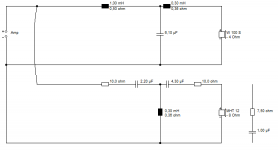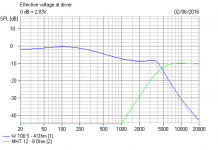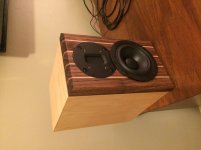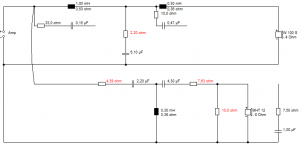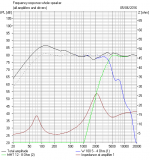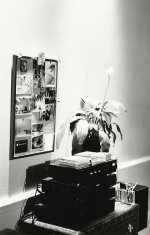Well tomorrow or the next day is the deadline for crossover changes so I think I'll just make sure to leave it accessible so I can tweak it in the future if I ever figure out where that high peak is coming from.
Your problem tweeter curve is a little tricky to correct as shown. It can be done, possibly by increasing series resistance but I think the issue is the simulated baffle diffraction.
This issue might be overstated by the sim. Not only this but it is not a problem that can be (or should be blindly attempted to be) fixed by a crossover.
The tweeter appears in the sim to be being run too hot. If it were me I'd cross the tweeter without the diffraction simmed, and attempt to reduce the diffraction only if it is a problem using something absorbent on the baffle.
This issue might be overstated by the sim. Not only this but it is not a problem that can be (or should be blindly attempted to be) fixed by a crossover.
The tweeter appears in the sim to be being run too hot. If it were me I'd cross the tweeter without the diffraction simmed, and attempt to reduce the diffraction only if it is a problem using something absorbent on the baffle.
Products_Fountek Electronics Co.,Ltd
https://sites.google.com/site/undefinition/speedster
Your build is just a 300Hz lower crossover than Paul Carmody's. It's otherwise identical. I used an 8mm offset on relative acoustic centres and it lines up either way.
Something is exagerrating the top end of the tweeter. Maybe your FRD file is not exact. Off-axis it should be flat enough.
Possibly a tweeter Zobel would help with a couple of dB at the very top. TBH, I would try to get nearer preferred values like 4.7uF and 6.8uF. Easier to buy.
https://sites.google.com/site/undefinition/speedster
Your build is just a 300Hz lower crossover than Paul Carmody's. It's otherwise identical. I used an 8mm offset on relative acoustic centres and it lines up either way.
Something is exagerrating the top end of the tweeter. Maybe your FRD file is not exact. Off-axis it should be flat enough.
Possibly a tweeter Zobel would help with a couple of dB at the very top. TBH, I would try to get nearer preferred values like 4.7uF and 6.8uF. Easier to buy.
Attachments
Last edited:
where that high peak is coming from.
It's normal if you use too low capacitor and the rest of the bandwidth is so attenuated. It's not normal for a woofer to have such a low sensitivity like yours. Check again the FRD of the woofer and make sure it is "normalized" with the tweeter FRD.
In fact the two crossovers are almost identical. Any problems with a peaky high end are inherent in the ribbon tweeter.
Paul Carmody thought it sounded OK, but there is a tendency to a bright top. It's in the FR of the tweeter. A diffraction issue in the rectangular diaphragm, IMO. These things can sound bright on axis.
It's one of those things that are a balance really. Power response versus frequency response.
Paul Carmody thought it sounded OK, but there is a tendency to a bright top. It's in the FR of the tweeter. A diffraction issue in the rectangular diaphragm, IMO. These things can sound bright on axis.
It's one of those things that are a balance really. Power response versus frequency response.
Attachments
Products_Fountek Electronics Co.,Ltd
https://sites.google.com/site/undefinition/speedster
Your build is just a 300Hz lower crossover than Paul Carmody's. It's otherwise identical. I used an 8mm offset on relative acoustic centres and it lines up either way.
Something is exagerrating the top end of the tweeter. Maybe your FRD file is not exact. Off-axis it should be flat enough.
Possibly a tweeter Zobel would help with a couple of dB at the very top. TBH, I would try to get nearer preferred values like 4.7uF and 6.8uF. Easier to buy.
Well, It's good to know I got so close on my own to what a more experienced designer did. I used a real-time analyzer to look at the peak as I was moving the mic around, it did diminish off-axis, but honestly not as much as I hoped.
I measured the tweeter 3 times, triple checking my set-up, and I, too, used an 8mm offset and it lined up pretty well.
I think the bottom line is that my expectations for a speaker of this caliber were too high. Don't get me wrong, they sound good. I think I was expecting reference quality. I also can't do tricks like put a soft fabric on the baffle - I don't want to cover up my woodwork!
I believe the reason my ears prefer the brighter setting on the woofer is because in the current physical location that 115Hz peak is very audible, and so is the 12kHz peak, therefore I felt like it was lacking in the presence range.
We will be moving soon and these will go in a larger room, where I think both of those issue will be more negligible. I think I'll take your advice and move my values a pinch toward Carmody's.
The biggest challenge here is only have about 3 hours total tweak time (my last project was probably ~30 listening hours). So I'll just be sure to leave it accessible for after the move.
Products_Fountek Electronics Co.,Ltd
https://sites.google.com/site/undefinition/speedster
Your build is just a 300Hz lower crossover than Paul Carmody's. It's otherwise identical. I used an 8mm offset on relative acoustic centres and it lines up either way.
Something is exagerrating the top end of the tweeter. Maybe your FRD file is not exact. Off-axis it should be flat enough.
Possibly a tweeter Zobel would help with a couple of dB at the very top. TBH, I would try to get nearer preferred values like 4.7uF and 6.8uF. Easier to buy.
Zobel looks really nice in simulation, I'll try it tomorrow night and see how it goes!
Attachments
Bit after the event, I know, but an MTM is better idea with a ribbon type tweeter IMO.
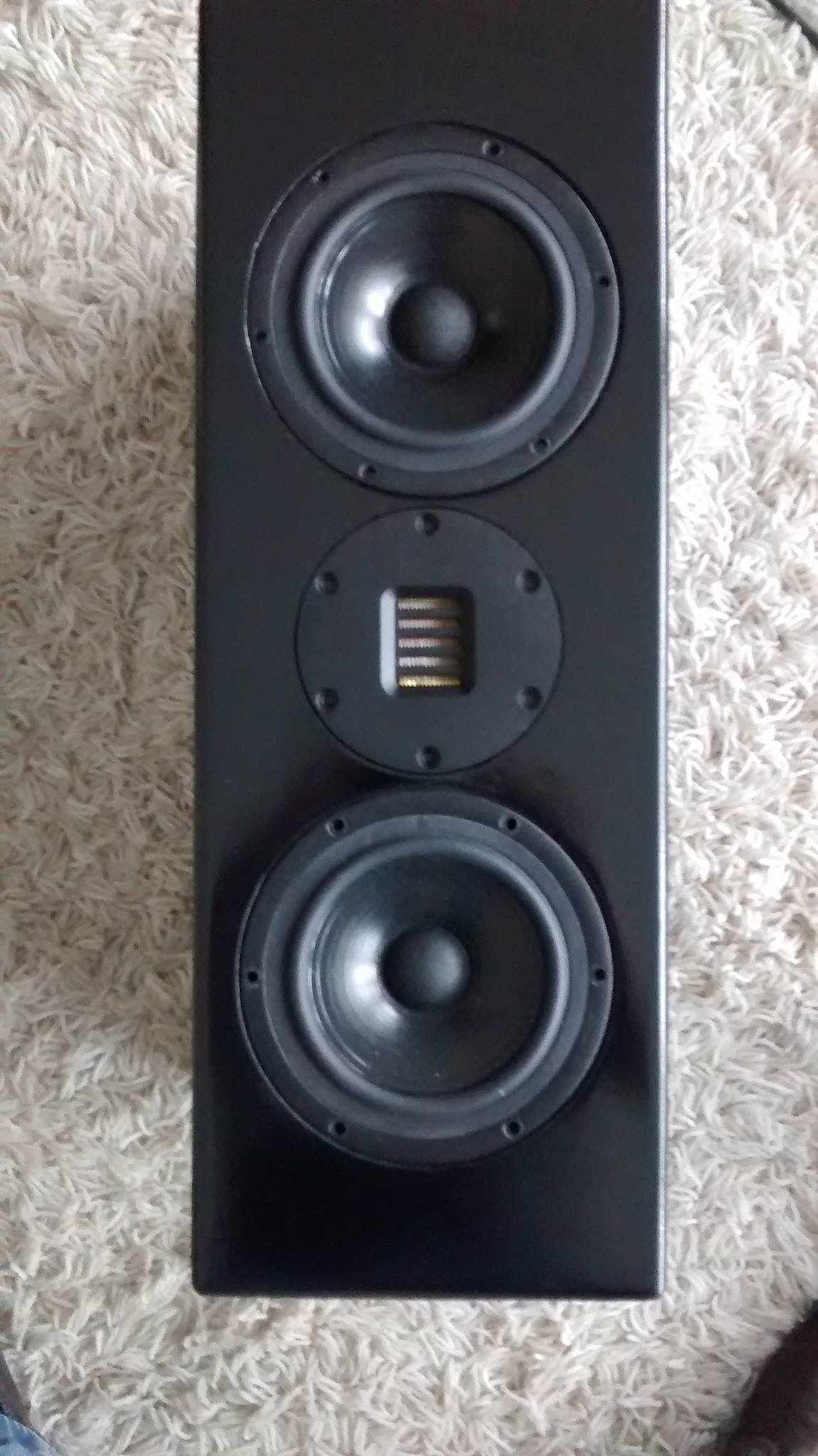
http://www.diyaudio.com/forums/multi-way/289344-seas-ca15rly-x2-cabinet-volume-suggestions.html
It cures some of the dispersion issues, and the varying falloff with distance of the drivers. Spherical and cylindrical have different properties. People mention combing, but that just sounds like the usual off-axis issues to me.
I don't think you need change the circuit except to try a zobel of some sort. Bass is always difficult with small speakers. There just isn't much of it really, and it can be a bit one-note if peaked.

http://www.diyaudio.com/forums/multi-way/289344-seas-ca15rly-x2-cabinet-volume-suggestions.html
It cures some of the dispersion issues, and the varying falloff with distance of the drivers. Spherical and cylindrical have different properties. People mention combing, but that just sounds like the usual off-axis issues to me.
I don't think you need change the circuit except to try a zobel of some sort. Bass is always difficult with small speakers. There just isn't much of it really, and it can be a bit one-note if peaked.
Crisis or opportunity? The reality of finding a source position that boosts below 100Hz might just give you a dip at 115Hz. At these frequencies the room has the more significant influence and it is worth playing the juggling act.in the current physical location that 115Hz peak is very audible,
Opportunity, for sure, but only with a redesign. The lack of presence in the bass must be due to the single bass drivers. Twin basses just project better.
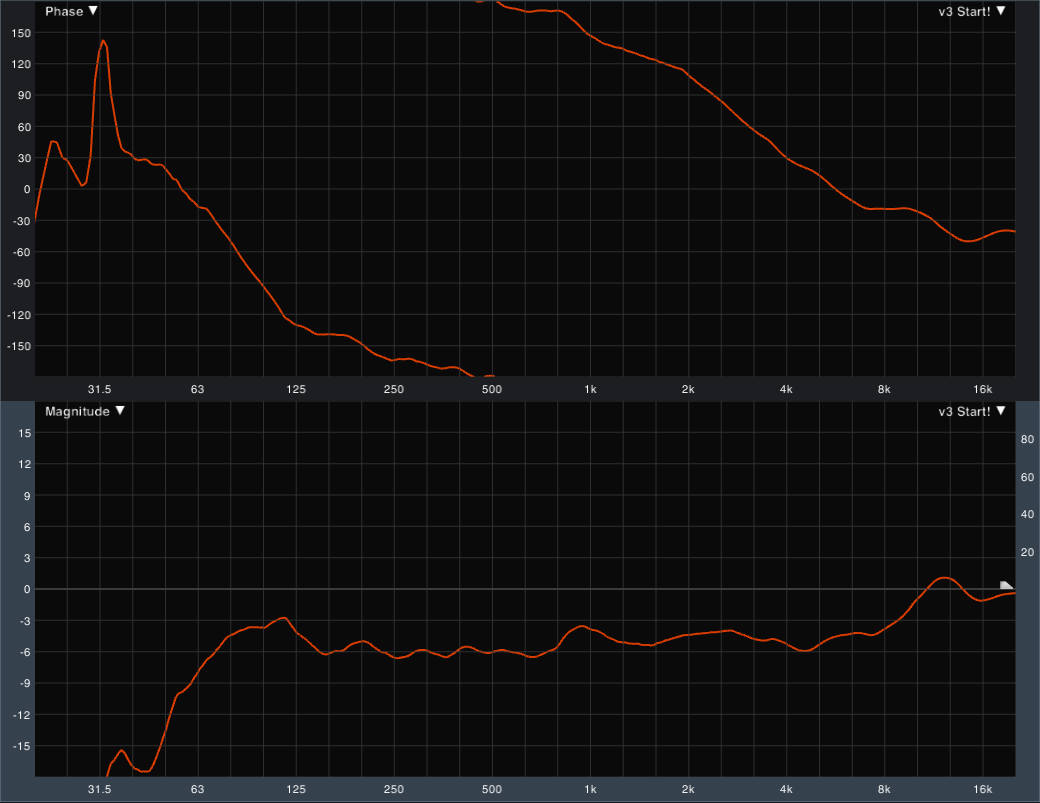
AFAIK, room acoustics exert a big influence on perceived bass. But how it seems to work is that dual drivers, or a cylindrical topology fall off less with distance in a big room.
TBH, there's no replacement for displacement with bass, so bigger drivers work better, but doubled-up small ones have strengths.

AFAIK, room acoustics exert a big influence on perceived bass. But how it seems to work is that dual drivers, or a cylindrical topology fall off less with distance in a big room.
TBH, there's no replacement for displacement with bass, so bigger drivers work better, but doubled-up small ones have strengths.
Attachments
Opportunity, for sure, but only with a redesign. The lack of presence in the bass must be due to the single bass drivers. Twin basses just project better.

AFAIK, room acoustics exert a big influence on perceived bass. But how it seems to work is that dual drivers, or a cylindrical topology fall off less with distance in a big room.
TBH, there's no replacement for displacement with bass, so bigger drivers work better, but doubled-up small ones have strengths.
Sorry for a miscommunication here. I mean the "presence" region as in 2-5kHz. These have an amazing amount of bass - no problem there. Both drivers have a small dip around 4.5kHz and somehow it's audible even with the rest of that region is a bit hotter than normal. Though, I'm wondering if applying this zobel network will change that perception.
Whatever way you change it, it should depend on the response you get in the end.I'm wondering if applying this zobel network will change that perception.
One problem can be not cutting a woofer breakup region out fully when it happens in this region, because cone breakup is more than just a response problem.
I think the bottom line is that my expectations for a speaker of this caliber were too high.
May be your expectation is not really too high. You are just not aware yet that good drivers will not automatically translate into good speakers.
I've just realised you are using less bafflestep than Paul Carmody:
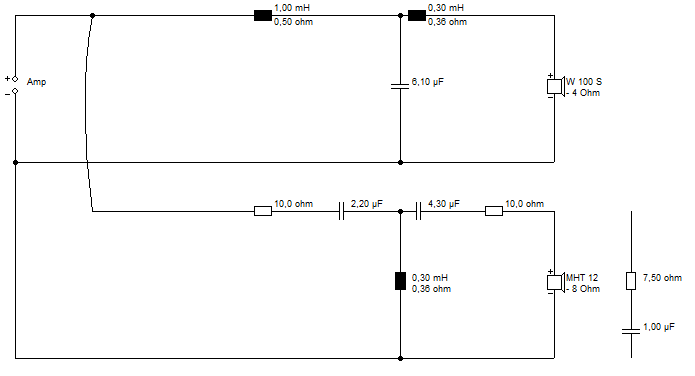
I think you need to raise the tweeter level 3dB to achieve his balance. Quick and dirty, just change the 10R to a 4.7R at the input. It helps the slope too. There's also something to be said for putting a 0.47uF across the 0.3mH in the bass filter, a la Louis Coraggio's Piccolata.
Piccolata Mini Monitor
https://sites.google.com/site/undefinition/speedster

I think you need to raise the tweeter level 3dB to achieve his balance. Quick and dirty, just change the 10R to a 4.7R at the input. It helps the slope too. There's also something to be said for putting a 0.47uF across the 0.3mH in the bass filter, a la Louis Coraggio's Piccolata.
Piccolata Mini Monitor
https://sites.google.com/site/undefinition/speedster
Last edited:
I've just realised you are using less bafflestep than Paul Carmody:

I think you need to raise the tweeter level 3dB to achieve his balance. Quick and dirty, just change the 10R to a 4.7R at the input. It helps the slope too. There's also something to be said for putting a 0.47uF across the 0.3mH in the bass filter, a la Louis Coraggio's Piccolata.
Piccolata Mini Monitor
https://sites.google.com/site/undefinition/speedster
I ended up splitting the difference and going with 7 ohm. I might brighten it up later, but I'm pretty happy with it for now, considering I've had only about 4 hours of listening.
Sorry if the picture is sideways - it's not on my computer, just on the website . . .?
What does the "0.47uF across the 0.3mH" accomplish?
Attachments
I've just realised you are using less bafflestep than Paul Carmody:

I think you need to raise the tweeter level 3dB to achieve his balance. Quick and dirty, just change the 10R to a 4.7R at the input. It helps the slope too. There's also something to be said for putting a 0.47uF across the 0.3mH in the bass filter, a la Louis Coraggio's Piccolata.
Piccolata Mini Monitor
https://sites.google.com/site/undefinition/speedster
Two follow-up questions- What are you using to post the XO schematics? It looks so much nicer than my screenshots of PCD 🙂
And of all the designs I've seen, it doesn't look like anyone did any cabinet bracing. What's up with that? There are certainly frequencies high enough inside the cabinet to resonate those small panels, and with only .5" walls I'm sure we're wasting just a smidgen of energy (not that these are short on power).
The simmer I use, mainly because I like the optimiser function when I get stumped for ideas, is Visaton Boxsim: Downloads
You just mark appropriate components "optimize" and the computer does it's best to improve it. TBH it's useless on BW3 since it always tries to phase align, but I have workarounds. You can also adjust acoustic centres to correspond to baffle alignment, but I guess most sims can do that.
You can import a similar project like the Aria Light here into the projekte folder and save yourself a whole lot of work.
boxsim-db.de | Boxsim Projektdatenbank
Not hard to change to the 4 ohm W100S driver, or MHT12 ribbon tweeter to get quite close to where you are.
Your TB W4-1720 4" woofer looks like this on FR:
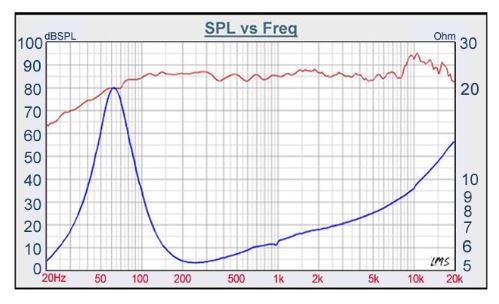
Clearly a bit of an issue with bass cone breakup at about 10kHz. Hence the notch idea. Is it overly fussy to fix it? Is the rising tweeter top end worth fixing? It's your speaker. 😀
Below are some elements you might try. Minor tweaks really, but they all do something good IMO. The 7.5R and 1uF zobel does interact with the 10R tweeter shunt, but you might settle for 22R. This is the game. Where do you say, enough! I'll stop there. 😱
You just mark appropriate components "optimize" and the computer does it's best to improve it. TBH it's useless on BW3 since it always tries to phase align, but I have workarounds. You can also adjust acoustic centres to correspond to baffle alignment, but I guess most sims can do that.
You can import a similar project like the Aria Light here into the projekte folder and save yourself a whole lot of work.
boxsim-db.de | Boxsim Projektdatenbank
Not hard to change to the 4 ohm W100S driver, or MHT12 ribbon tweeter to get quite close to where you are.
Your TB W4-1720 4" woofer looks like this on FR:

Clearly a bit of an issue with bass cone breakup at about 10kHz. Hence the notch idea. Is it overly fussy to fix it? Is the rising tweeter top end worth fixing? It's your speaker. 😀
Below are some elements you might try. Minor tweaks really, but they all do something good IMO. The 7.5R and 1uF zobel does interact with the 10R tweeter shunt, but you might settle for 22R. This is the game. Where do you say, enough! I'll stop there. 😱
Attachments
Last edited:
Hi Steve, thanks for filling me in! I get what you're saying about when to say "enough". Coming from live sound, I'm used to making changes until the end of the show! Looks like I'm completely out of time on this project, but I will say that combining the Zobel with raising the tweeter level overall really made the difference.
With my woofer cap being larger than other people's designs I'm not really seeing the woofer break-up region coming through. I feel pretty good about that area.
I think ultimately I probably want the tweeter a little hotter, but I'll wait to see what kind of room these will live in to make that decision. I wish I had a final free-air measurement to share, but the clock has run out. I had an unexpected 20 minutes to listen this even and I was pretty happy. I'll post any updates as they come. Unless she hates them. . .
P.S. I auditioned every type of music I have on these and they translated well, with the one exception of my Audio Slave test track "out of exile". That track is brutally honest on guitar tones - if your mids aren't right, that song will let you know! And I just didn't get excited about it with these. Fortunately for me - she doesn't listen to Audio Slave 🙂
With my woofer cap being larger than other people's designs I'm not really seeing the woofer break-up region coming through. I feel pretty good about that area.
I think ultimately I probably want the tweeter a little hotter, but I'll wait to see what kind of room these will live in to make that decision. I wish I had a final free-air measurement to share, but the clock has run out. I had an unexpected 20 minutes to listen this even and I was pretty happy. I'll post any updates as they come. Unless she hates them. . .
P.S. I auditioned every type of music I have on these and they translated well, with the one exception of my Audio Slave test track "out of exile". That track is brutally honest on guitar tones - if your mids aren't right, that song will let you know! And I just didn't get excited about it with these. Fortunately for me - she doesn't listen to Audio Slave 🙂
Last edited:
Nathan, that was fascinating, and a really good project well executed. 😀
Definitely Paul Carmody's Speedster improved, and I think you CAN stop there. These are pleasant speakers IMO. The necessary highish 4kHz crossover and tiny bass are the main factors, and you've done well with them IMO.
It's all such a trade-off with speakers, but reducing the bafflestep has gotta be more real world. I hate intrusive lumpy bass notes, and we always place near some surface in practise, which does (mainly) reinforcing things to the bass.
Just for interest, here's how flush wall mounting would affect those speakers. Just shows the tendency to placement effects in an interesting way. Wiggly diffraction effects go up to 7kHz on 6" baffle! 😱
I had some MS10i speakers like these years ago. They seemed nice on stands near the wall in a small room.
Definitely Paul Carmody's Speedster improved, and I think you CAN stop there. These are pleasant speakers IMO. The necessary highish 4kHz crossover and tiny bass are the main factors, and you've done well with them IMO.
It's all such a trade-off with speakers, but reducing the bafflestep has gotta be more real world. I hate intrusive lumpy bass notes, and we always place near some surface in practise, which does (mainly) reinforcing things to the bass.
Just for interest, here's how flush wall mounting would affect those speakers. Just shows the tendency to placement effects in an interesting way. Wiggly diffraction effects go up to 7kHz on 6" baffle! 😱
I had some MS10i speakers like these years ago. They seemed nice on stands near the wall in a small room.
Attachments
Follow-up question for these. Why do you think none of the designs with this driver configuration used any internal cabinet bracing. I'm not one of those bracing nuts, but it seems that with only .5" side panels it would be a concern.
- Status
- Not open for further replies.
- Home
- Loudspeakers
- Multi-Way
- How to Tweak a Passive Crossover
